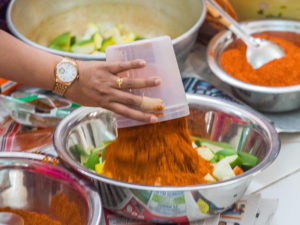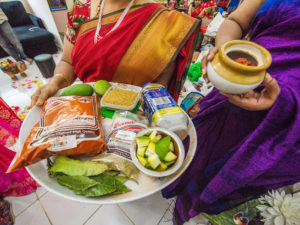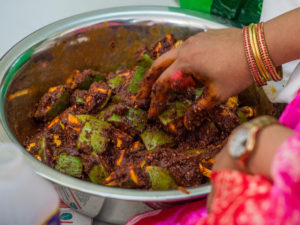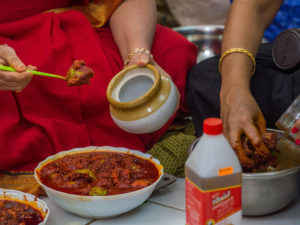The spicy, fiery, delectable pickles have been made by countless generations of women in Andhra at the onset of summer as the bitingly sour varieties of raw mangoes arrive in the market.
Every grandmother, mother and daughter was adept at this art. Pickle making was a family or community affair where relatives or neighbours would get together on appointed days to get the magic started. It was not just women, children would also happily participate in a small measure by running errands. Their reward: a morsel of steaming hot rice mixed with freshly prepared mango pickle with a dollop of butter or ghee [clarified butter] to anoint the heat. The glee on the child’s face!

These are what go into the world-famous Andhra mango pickles, whose variety and incendiary joy are known to Indian pickle aficionados across the world.
Now, few young Andhra women know how to make this pickle and with expatriate Andhra families, the pickling tradition is confined to carrying the precious cargo from back home, made by grandma or mum or an aunt.
The pickle ‘workshop’, as the ladies called it, also included a volunteer each from the states of Kerala and Karnataka to make, and revive, the legendary ‘avakaya’ as the pickle is called in Andhra.
It all started with a discussion on WhatsApp group on the pickle-grade, sour mangoes now available in the Hyderabad, says Nauduri Vasantha Lakshmi, a working woman with two children. Vasantha, who is one of those who depend on their mothers for their annual supply of the pickle, says unless she herself knows the process, she wouldn’t be able to teach it to her daughter.
Of course, there are versions of avakaya available in the shops but do they hold a candle?
When Vasantha suggested the idea, her friend Lakshmi Kameshwari agreed to host the pickle making session at her residence in Gachibowli area. And others kept joining the group and soon it swelled to 15 women.

The art of avakaya making begins with the selection of raw mangoes. The mangoes should be of nearly the same size, or the pickle will end up with varying sized pieces. Then, each mango needs to be cut into nearly identical sized pieces.
Then comes the actual mixing of the pickle. The mounds of red chilli powder, mustard powder, oil, and salt need to be mixed by hand, a labour of love and tolerance as the chilli powder reveals its heat. Then, once the pickle base is thoroughly mixed, the spices and oil need to be lovingly massaged into the pieces making sure each piece is well coated with the spices. Your hands by this time resemble Lady Macbeth’s but unlike her, there is no burning desire to reach for all the perfumes to wash off the smell. The aroma of fresh pickle powder holds the memories of many summers of gastronomic delights!
Once the pieces are smothered with the spices, they go into clean, sun-warmed porcelain or glass jars. At the residence, the women, having successfully completed the ritual, their hands still ablaze with the spices, gleefully introduced steaming white rice to the residual spice mix in the bowls. A dollop of butter tossed in and the repast was well worth the effort.
The taste of the freshly made avakaya took me the closest to what my mother made, and we devoured, year after year.
Spices being mixed with raw mango pieces.

Basic Mango Pickle recipe of Telugu states
Ingredients:
– 3-4 medium sized sour green mangoes
– 250 gm freshly ground sun-dried mustard powder
– 250 gm Bellary/Warangal/Kashmiri red chilly powder
– 250 gm salt
– 1 1/2 tablespoon fenugreek seeds
– 1 litre sesame oil
– 100 gm peeled Indian garlic pods
Note: Mustard powder, chilly powder and salt should always be in equal proportions.
Method
– Mix items 2,3 and 4 thoroughly.
– Wash mangoes, wipe clean, and air dry them for some time.
– Cut the mangoes into 1.5 inch square pieces.
– Remove the kernel, it is not used in the pickle.
– Take a medium sized cup or bowl for measurement and a large bowl for mixing the pickle.
– For every 1.5 cup/bowl of mango pieces, 1 cup of the spice mixture is needed.
– Mix the mango pieces, fenugreek seeds, garlic pods (optional), and the spice mixture very well in the large bowl.
– Then slowly add sesame oil till the spice powder is sticky but not wet with oil.
– Transfer this mix to a tall and wide airtight glass container. Press down the pickle mix tightly and close the lid.
Let the pickle rest for three days. The mango pieces would have softened mildly by now and oil must rise at least 2 inches above the pickle surface. If you do not see that much oil, you should add some now. Taste the pickle for salt. If necessary, add some more.
Mix well and let it rest for a day or two before consumption.
The flavour of mustard may seem too strong in first week. By week 2, the sourness of mango seeps into the spices, fenugreek seeds, and garlic pods, and pickle becomes tasty.

Andhra pickles typically made during the mango season:
1. Avakaya (basic type)
2. Vellulli Avakaya (basic + garlic pods)
3. Allam Vellulli avakaya (ginger garlic mango pickle)
4. Pesara Avakaya (with moong dal powder)
5. Pulihora Avakaya (pulihora-flavoured avakaya)
6. Thokkudu pacchadi (grated mango pickle)
7. Menthi karam (fenugreek-flavoured pickle)
One tiny dot of the pickle was enough to bring on the tears for our photographer Antonin Kelian Kallouche and videographer Logan Fish. ‘Wow, never tasted anything like this before!’, was their expression. #KhabarLive
